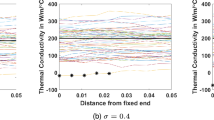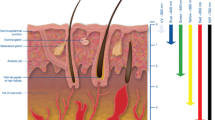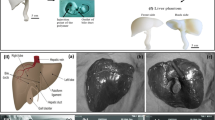Abstract
This paper presents an approach to determine a model of superficial tissue temperature dynamics during continuous wave CO\(_2\) laser irradiation. The main contribution of this research is the use of real data to model the thermal state of targets being irradiated with surgical laser, using statistical learning methods. To the best of our knowledge this is the first time that these methods have been applied in this field. This work extends previous results which demonstrated, in simulation, the relevance and utility of machine learning methods in modeling the thermal state of tissue during laser surgical procedures. Here we use real data, captured with a thermal camera, to learn the function mapping from laser inputs to the corresponding changes in tissue temperature. Based on features observed in the real data, a new structure for the model as well as a different learning approach are proposed.
















Similar content being viewed by others
References
Steine W, Ambrosch P (2000) Endoscopic laser surgery of the upper aerodigestive tract: with special emphasis on cancer surgery. Thieme, Stuttgart
Lumenis inc., Co\(_2\) laser accesories. [Online]. http://www.surgical.lumenis.com/pdf/PB006035_B_CO2_Accessories.pdf. Accessed 17 Oct 2014
uRalp Consortium [Online]. Micro-technologies and systems for robot-assisted laser phonomicrosurgery, EU project—grant agreement 288663. http://www.microralp.eu. Accessed 17 Oct 2014
Mattos LS, Dellepiane M, Caldwell D (2011) Next-generation micromanipulator for computer-assisted laser phonomicrosurgery. In Engineering in medicine and biology society, EMBC, 2011 annual international conference of the IEEE, vol 30. 3 Sept 2011, pp 4555–4559.
Mohri M, Rostamizadeh A, Talwalkar A (2012) Foundations of machine learning. MIT press, Cambridge
Niemz M (2003) Laser-tissue interactions. Springer, Berlin
Cox B (2014) Optics in medicine: introduction to laser-tissue interactions (Course Notes for MPHY3886). Downloaded in Fall from http://www.ucl.ac.uk/medphys/staff/people/bcox/BenCox_LaserTissueInteractions.pdf
Steiner R (2011) Laser-tissue interactions. Laser and IPL technology in dermatology and aesthetic medicine. Springer, Berlin, pp 23–36
Saccomandi P, Schena E, Silvestri S (2013) Techniques for temperature monitoring during laser-induced thermotherapy: an overview. Int J Hyperth 29(7):609–619
Jiao J, Guo Z (2009) Thermal interaction of short-pulsed laser focused beams with skin tissues. Phys Med Biol 54(13):4225–4241
Ahmed EM, Barrera FJ, Early EA, Denton ML, Clark CD, Sardar DK (2013) Maxwell’s equations-based dynamic laser tissue interaction model. Comput Biol Med 43(12):2278–2286
Crochet JJ, Gnyawali SC, Chen Y, Lemley EC, Wang LV, Chen WR (2006) Temperature distribution in selective laser-tissue. J Biomed Opt 11(3):01–10
Fichera L, Pardo D, Mattos L (2013) Modeling tissue temperature dynamics during laser exposure. Advances in computational intelligence—IWANN13, vol 7903. Springer, Berlin
Vijayakumar S, D’Souza A, Schaal S (2005) Incremental online learning in high dimensions. Neural Comput 17:2602–2634
Vogel A, Venugopalan V (2003) Mechanisms of pulsed laser ablation of biological tissues. Chem Rev 103(2):577–644
Svelto O (2010) Principles of lasers. Springer, New York
Caruana R, Searle R, Heller T, Shupack S (1986) Fast algorithm for the resoluton of spectra. Anal Chem 58(6):1162–1167
Guo H (2011) A simple algorithm for fitting a gaussian function. IEEE Signal Process Mag 28:134–137
Rastegar S, van Gemert MJC, Welch AJ, Hayes LJ (1988) Laser ablation of discs of agar gel. Phys Med Biol 33:133
Acknowledgments
The research leading to these results has received funding from the European Union Seventh Framework Programme FP7\(/\)2007–2013—Challenge 2—Cognitive Systems, Interaction, Robotics—under Grant agreement \(\mu \)RALP \(^{\circ }\) 288233.
Author information
Authors and Affiliations
Corresponding author
Rights and permissions
About this article
Cite this article
Pardo, D., Fichera, L., Caldwell, D. et al. Learning Temperature Dynamics on Agar-Based Phantom Tissue Surface During Single Point CO\(_2\) Laser Exposure. Neural Process Lett 42, 55–70 (2015). https://doi.org/10.1007/s11063-014-9389-y
Published:
Issue Date:
DOI: https://doi.org/10.1007/s11063-014-9389-y




